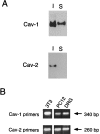Expression of caveolin-1 and -2 in differentiating PC12 cells and dorsal root ganglion neurons: caveolin-2 is up-regulated in response to cell injury
- PMID: 9707634
- PMCID: PMC21495
- DOI: 10.1073/pnas.95.17.10257
Expression of caveolin-1 and -2 in differentiating PC12 cells and dorsal root ganglion neurons: caveolin-2 is up-regulated in response to cell injury
Abstract
Caveolae are cholesterol/sphingolipid-rich microdomains of the plasma membrane that have been implicated in signal transduction and vesicular trafficking. Caveolins are a family of caveolae-associated integral membrane proteins. Caveolin-1 and -2 show the widest range of expression, whereas caveolin-3 expression is restricted to muscle cell types. It has been previously reported that little or no caveolin mRNA species are detectable in the brain by Northern blot analyses or in neuroblastoma cell lines. However, it remains unknown whether caveolins are expressed within neuronal cells. Here we demonstrate the expression of caveolin-1 and -2 in differentiating PC12 cells and dorsal root ganglion (DRG) neurons by using mono-specific antibody probes. In PC12 cells, caveolin-1 expression is up-regulated on day 4 of nerve growth factor (NGF) treatment, whereas caveolin-2 expression is transiently up-regulated early in the differentiation program and then rapidly down-regulated. Interestingly, caveolin-2 is up-regulated in response to the mechanical injury of differentiated PC12 cells; up-regulation of caveolin-2 under these conditions is strictly dependent on continued treatment with NGF. Robust expression of caveolin-1 and -2 is also observed along the entire cell surface of DRG neurons, including high levels on growth cones. These findings demonstrate that neuronal cells express caveolins.
Figures






Similar articles
-
Nerve Growth Factor Signaling from Membrane Microdomains to the Nucleus: Differential Regulation by Caveolins.Int J Mol Sci. 2017 Mar 24;18(4):693. doi: 10.3390/ijms18040693. Int J Mol Sci. 2017. PMID: 28338624 Free PMC article.
-
Identification of reggie-1 and reggie-2 as plasmamembrane-associated proteins which cocluster with activated GPI-anchored cell adhesion molecules in non-caveolar micropatches in neurons.J Neurobiol. 1998 Dec;37(4):502-23. doi: 10.1002/(sici)1097-4695(199812)37:4<502::aid-neu2>3.0.co;2-s. J Neurobiol. 1998. PMID: 9858255
-
Neurite outgrowth and GAP-43 mRNA expression in cultured adult rat dorsal root ganglion neurons: effects of NGF or prior peripheral axotomy.J Neurosci Res. 1994 Dec 15;39(6):634-45. doi: 10.1002/jnr.490390603. J Neurosci Res. 1994. PMID: 7534832
-
Role of neurotrophin signalling in the differentiation of neurons from dorsal root ganglia and sympathetic ganglia.Cell Tissue Res. 2009 Jun;336(3):349-84. doi: 10.1007/s00441-009-0784-z. Epub 2009 Apr 23. Cell Tissue Res. 2009. PMID: 19387688 Review.
-
Caveolin-1 in breast cancer.Cancer Biol Ther. 2004 Oct;3(10):931-41. doi: 10.4161/cbt.3.10.1147. Epub 2004 Oct 28. Cancer Biol Ther. 2004. PMID: 15539932 Review.
Cited by
-
Distribution of caveolin isoforms in the lemur retina.J Vet Sci. 2007 Sep;8(3):295-7. doi: 10.4142/jvs.2007.8.3.295. J Vet Sci. 2007. PMID: 17679778 Free PMC article.
-
Essential role of ATP6AP2 enrichment in caveolae/lipid raft microdomains for the induction of neuronal differentiation of stem cells.Stem Cell Res Ther. 2018 May 11;9(1):132. doi: 10.1186/s13287-018-0862-9. Stem Cell Res Ther. 2018. PMID: 29751779 Free PMC article.
-
Caveolin-1 plays a crucial role in inhibiting neuronal differentiation of neural stem/progenitor cells via VEGF signaling-dependent pathway.PLoS One. 2011;6(8):e22901. doi: 10.1371/journal.pone.0022901. Epub 2011 Aug 3. PLoS One. 2011. PMID: 21826216 Free PMC article.
-
Three-dimensional, computer-tomographic analysis of membrane proteins (TrkA, caveolin, clathrin) in PC12 cells.Acta Histochem Cytochem. 2007 Jul 3;40(3):93-9. doi: 10.1267/ahc.07009. Acta Histochem Cytochem. 2007. PMID: 17653301 Free PMC article.
-
Co-regulation of caveolar and Cdc42-dependent fluid phase endocytosis by phosphocaveolin-1.J Biol Chem. 2010 May 14;285(20):15119-15125. doi: 10.1074/jbc.M109.069427. Epub 2010 Mar 12. J Biol Chem. 2010. PMID: 20228056 Free PMC article.
References
-
- Lisanti M P, Scherer P, Tang Z-L, Sargiacomo M. Trends Cell Biol. 1994;4:231–235. - PubMed
-
- Couet J, Li S, Okamoto T, Scherer P S, Lisanti M P. Trends Cardiovasc Med. 1997;7:103–110. - PubMed
-
- Okamoto T, Schlegel A, Scherer P E, Lisanti M P. J Biol Chem. 1998;273:5419–5422. - PubMed
-
- Scherer P E, Lewis R Y, Volonté D, Engelman J A, Galbiati F, Couet J, Kohtz D S, van Donselaar E, Peters P, Lisanti M P. J Biol Chem. 1997;272:29337–29346. - PubMed
-
- Song K S, Scherer P E, Tang Z-L, Okamoto T, Li S, Chafel M, Chu C, Kohtz D S, Lisanti M P. J Biol Chem. 1996;271:15160–15165. - PubMed
Publication types
MeSH terms
Substances
Grants and funding
LinkOut - more resources
Full Text Sources
Other Literature Sources
Molecular Biology Databases

